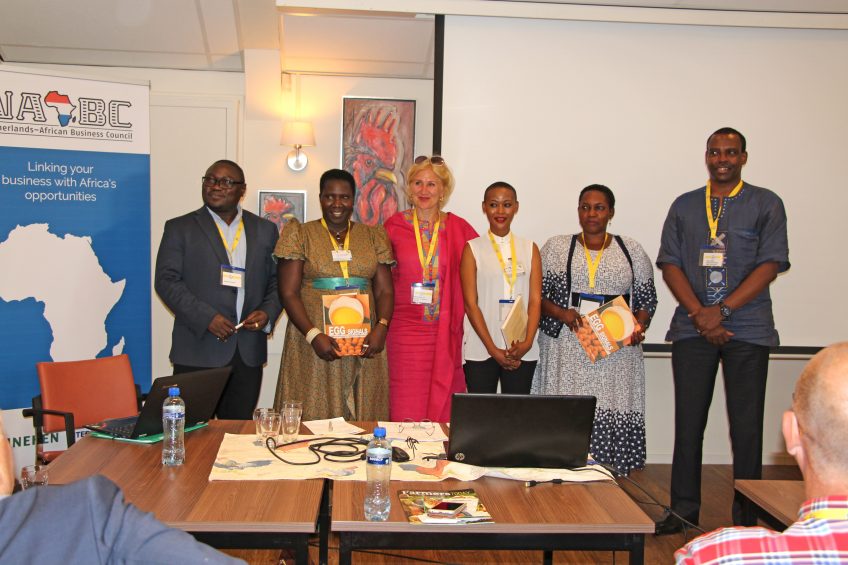East-African poultry sector matures

With a global increase in demand for poultry and eggs in countries with growing populations and an increase in wealth. It follows that there is an opportunity for production growth. East-Africa has such opportunities. As its poultry sector matures and professionalises – it can overcome the challenges.
Dutch Poultry Centre (DPC), the Netherlands-African Business Council (NABC) and VIV worldwide recently organised the ‘Poultry in East-Africa Event’ symposium, which featured farmers and ambassadors from two African countries, Rwanda and Uganda. The meeting revolved around the opportunities in these African countries for poultry farmers and agro-processing companies worldwide.
During the event, Ambassador of the Republic of Uganda Embassy in Brussels accredited to Europe Mrs Mirjam Blaak Sow, gave a presentation about ‘Investment Opportunities in Uganda’. She said that unfortunately the effects of climate change are also a reality in Uganda. “However, we’re taking more measures in order to cope with climate change.” According to her, Uganda offers great opportunities for poultry farmers around the world to invest. Mrs Blaak Sow: “We have a very liberal economic system. Our economic growth is currently an average of 5.4% annually, which will increase due to the oil and gas discoveries.” One of the great advantages of Uganda is that you have no obligation to work with Ugandan companies to set up a poultry farm, as is the case in many other countries worldwide. You cannot buy agricultural land in Uganda, but you can acquire land by means of ground lease. Mrs Blaak Sow: “If investors, such as European poultry farmers, have questions about these subjects, they can consult first and foremost the Uganda Investment Authority (UIA) which is the one-stop shop, facilitating investors and providing free advice assisting in obtaining licenses.”
Investment and trade opportunities
Uganda has broiler slaughterhouses and egg packing centres, but according to Mrs Blaak Sow, the country is still searching for more agro-processing companies. “We want to assist these kind of companies in every way to open new businesses. This is currently one of the spearheads of our government policy.” There’s a high demand for poultry products in schools, hotels, companies and organisations in Uganda. Until now, many poultry products are imported from Kenya and Rwanda. There is also a lack of knowledge and skills in poultry management and of capital to put the necessary infrastructure in place.
Mrs Blaak Sow: “We still have a poor road network and a limited farm or factory logistics infrastructure.” Because of the lack of reliable power supply in certain areas, Uganda is, currently, building a power supply of 600 Megawatt at Karuma Falls. This power supply will be ready in 2019. Also the poultry periphery in Uganda should develop more rapidly. There’s room for more hatcheries and feed factories in line with western standards. Concerning the approach to animal diseases, Uganda requires more professional care, knowledge and management. Mrs Blaak Sow: “Just like in Europe we isolate farms where animal disease outbreaks occur and we put a transport ban on poultry products to contain the outbreak.” The Poultry Association of Uganda is trying to become more professional to assist in developing the poultry sector. There is an incentive regime for investors in Uganda like duty and tax-free import on plant and machinery.
One of the poultry farmers present during the event in Barneveld is Anzoa Clara Aya of Aya Mixed farm in Uganda. Her farm is located in Moyo in North Western Uganda (West Nile). She currently has 3000 to 5000 birds. “I put broilers or layers on, depending on the market demand. However, I have a mixed farm, both poultry and over 200 pigs.” Ms Aya currently has semi-permanent houses constructed out of burnt bricks with local facilities, but is planning to upgrade and modernise. Of course it’s very hot in northern Uganda. Ms Aya, currently, has no remedy for that, the only measure to reduce heat stress is to reduce the number animals. Under normal circumstances she can only get stock after 30 days of giving an order, because the suppliers are stretched thin; supplying non-governmental organisations, government programmes and individual farmers in Uganda, South Sudan and parts of Democratic Republic of Congo.

Production for export markets has risen under the government project ‘Operation Wealth Creation’. Ms Aya: “There are also many training institutions that are educating Ugandans in Commercial poultry keeping.” Still, there are a number of factors that don’t make poultry keeping easy, like inadequate feed supplies due to droughts, a limited chicks supply base and limited capital for running modern facilities. Ms Aya: “Measures the government of Uganda can take are for example the elimination or reduction of taxes on poultry products, facilities and other inputs and give grants to support commercial poultry farmers, strengthen the National Poultry Farmers Network or consortium to promote poultry business. And link the domestic poultry farmers to the outside world for capacity building and market.”
Looking for farmers
Jean Pierre Karabaranga, Ambassador of the Republic of Rwanda in the Netherlands, said that Rwanda, with support of the Dutch government, is building a huge power plant in Kibuye. The plant will be ready within a few years. “This means that our energy supply keeps getting better.” The average economic growth in recent years in the Rwandan agricultural sector is at about 7.5%. Also, Rwanda has attractive incentives for investors. Accelerated depreciation of 50% for key priority sectors like manufacturing and agro-processing and duty free importation of machinery and equipment.
Rwanda is a huge consumer of poultry products. Mr Karabaranga: “Currently we import no less than 70% of these products from other African countries. 50% of our poultry products we now import from Uganda. We have too few poultry companies in our country and want poultry farmers from the rest of the world to come to us. Like Uganda, we would also like a poultry industry, but also builders and designers are welcome.”
Feed production situation
Adriaan Vernooij, researcher at Wageningen UR in the Netherlands, conducted a study on behalf of the Food and Business Knowledge Platform of the Dutch Ministry of Foreign Affairs, called ‘Poultry Development in Eastern Africa, a regional perspective’. According to Mr Vernooij the cost price for poultry production in Uganda is lower than in Rwanda and other African countries. Mr Vernooij: “Sufficient feed production is a problem in the whole region, also the supply of raw materials for feed production.” Tanzania has the lowest prices for poultry feed currently, an average of US$ 0.18 per kg.
Mr Vernooij: “Uganda also has relatively low feed prices and the advantage that many commodities can easily be grown for animal feed.” The prices for day old chicks (both layers and broilers) are also the lowest in Uganda and Tanzania. If we look at the challenges in animal feed, the cost price for most poultry products is determined mainly by the feed cost, and day old chicks. Mr Vernooij: “The market for poultry feed ingredients is quite complex with multiplicity of ingredients that are seasonally available. The prices aren’t consistent and the quality cannot always be guaranteed.” Wageningen University, with NABC (Netherlands Africa Business Council) and Agri Pro Focus will set up a pilot in the second half of 2017 in four African countries, Kenya, Rwanda, Tanzania and Uganda. Mr Vernooij: “It will be a comprehensive study to the prices for complete compound feed available in the local market. The results will be known in 2018 upon which a decision will be taken to broaden the study to other regions in Africa as well, for example Southern and Western Africa.
Jean Claude Ruzibiza is poultry farmer in Rwanda and president of the country’s national poultry association. He has 17,000 layers and has plans to increase that number. He wants to keep the layers in battery cages so he can produce more efficiently. His houses are built of concrete. Mr Ruzibiza: “To prevent the layers from suffering from the heat, the chicken houses are designed with large windows in order to increase the ventilation.” Most of the chicks are imported, but Mr Ruzibiza also gets his chicks from a few small hatcheries in Rwanda. “Some investors are now entering the hatchery business.” Getting sufficient good quality feed for the layers is one of the number one challenges for the poultry farmers in Rwanda, according to Mr Ruzibiza. “Most of the raw materials are imported. The supply chain is good and transport isn’t very expensive. The roads to my farm are also very good.”
The decision to locate his farm in the north of the country was initially based on the fact that he owns a small plot of land there. As a poultry farmer and the president of the national poultry association he thinks that the most important development in the Rwanda poultry sector is the professionalisation of the business, based on a good management system and using skilled staff, good quality chicken and feed, and to improve the production. “Also the use of modern technologies in chicken farming is a key point to reach a high and better profitability rate and a good market connection in the region. Gladly, we already have some investors in this sector.”

The main factors that make poultry farming not very easy in Rwanda are, according to Mr Ruzibiza, not enough experienced labour, the availability of layer/broiler chicks and the high feed prices. “We are researching the possibility of finding local ingredients that can be used as a substitute for chicken feed.” He thinks it’s important that the Rwandan government invests in chicken feed ingredient research and develop the practical skills of students in veterinary institutions, through internship and educational centres.













